-
View Larger Image
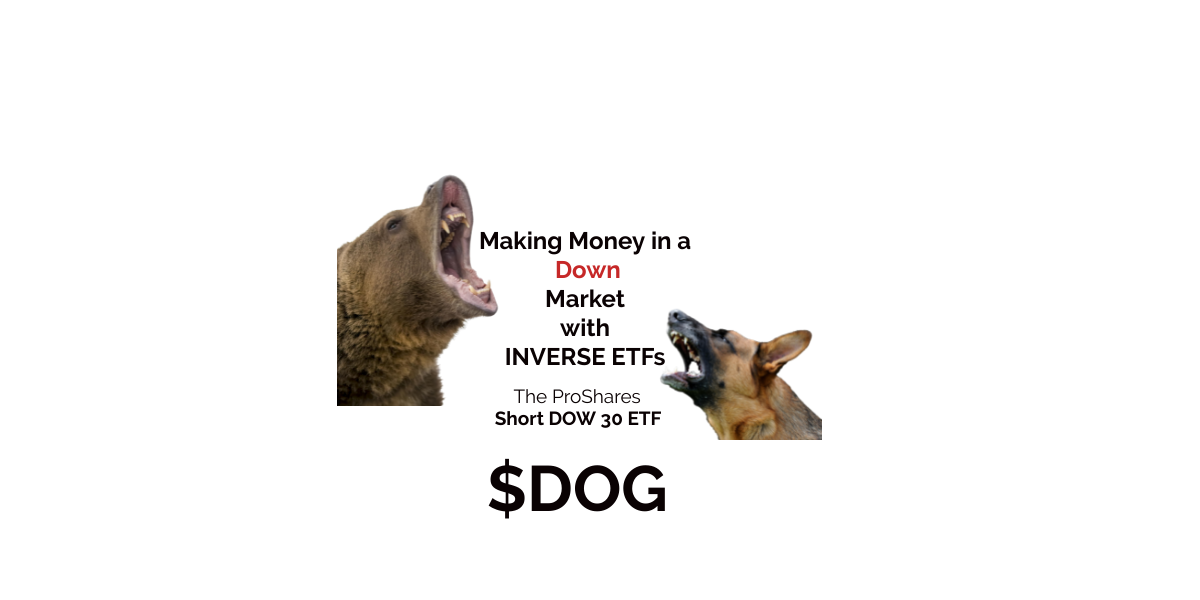
This week’s stock analy sis is ProShares Short Dow 30 ($DOG) .
One of the milestones that traders accomplish in their journey is thoroughly comprehending how to find the best opportunities in down markets. Initially, it is a mind bender. But as you confront the choices, possibilities, and potential strategies you quickly realize that it presents an opportunity from which there is great demand.
On Wall Street the most popular adage is to “buy low and sell high.” Everybody understands the idea. You buy something first and after ownership is accomplished you sell if at a higher price for a profit.
However, equally popular among professional traders is an adage which you rarely hear about. It states, “Sell High and Buy Low.” An astute reader will observe that in this adage you are simply selling first and buying second. The confusion among newcomers is, how can you sell something that you do not own? The answer to this question opens a completely different way of looking at markets and opportunities.
I want you to imagine that you overhear a conversation I’m having with a friend where I want to buy a Lexus SUV and am willing to pay $25,000. You don’t own a Lexus, but you think that you can purchase one for a lower price. So, you approach me and agree to deliver a Lexus SUV to me at a price of $25,000. We agree and enter the transaction with one another.
What has occurred here? I, as the buyer, have established a buying price of $25,000 for the car I want. You as the seller, have agreed to deliver that Lexus to me at the price of $25,000. You do not currently have the Lexus SUV in your inventory. Your current challenge is that if you can find a Lexus SUV at a lower price than $25,000, you will have created a profit for yourself. If you have to pay more than $25,000, you will have created a loss for yourself. In other words, you are “SHORT” the Lexus SUV when you enter into the agreement with me. In other words, you have SOLD first in the hopes of being able to buy the LEXUS at a lower price. SELL High, Buy Low is the process and workflow that you followed.
Observe that by SELLING first, you are simply reversing the order of the traditionally understood transaction. You have obligated yourself to make delivery of the Lexus SUV and your profit or loss on the transaction will depend upon your ability to access the Lexus SUV. If you access the Lexus SUV at $30,000 you will have a $5,000 loss, if you access the Lexus SUV at $20,000 you will have a $5,000 profit.
What I have just described is a very simplified and the basic concept behind short selling. When you understand this premise, you can begin to comprehend the opportunity that opens up in declining markets.
All you have to do is look at the popular broad stock market indexes and follow the artificial intelligence forecast and you can see that over the last several weeks they have been flashing warning signs for traders. Fundamentally this is because the Federal Reserve has been warning that it will raise interest rates and stop purchasing bonds by the end of March 2022.
Let’s look at some charts.
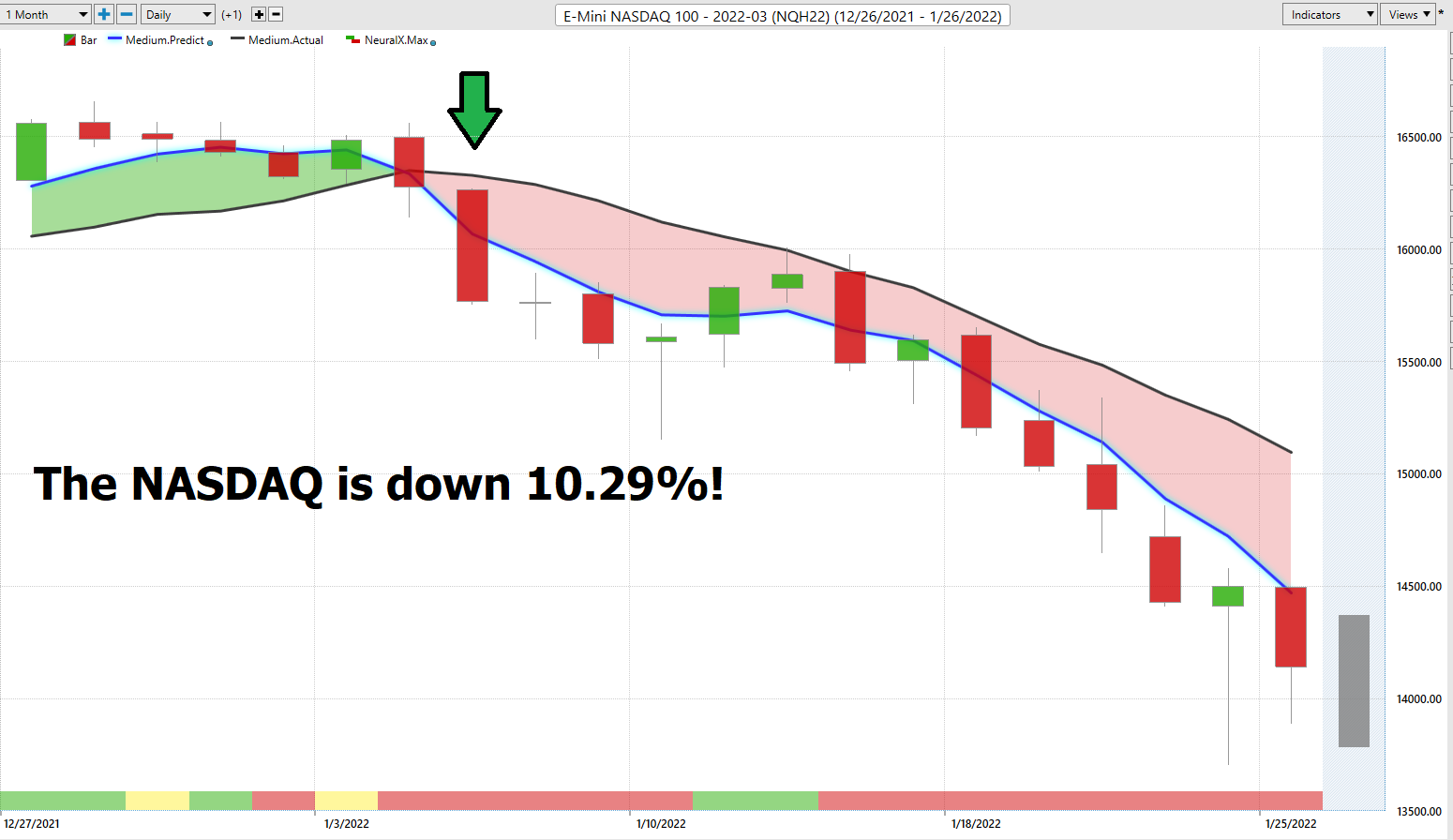
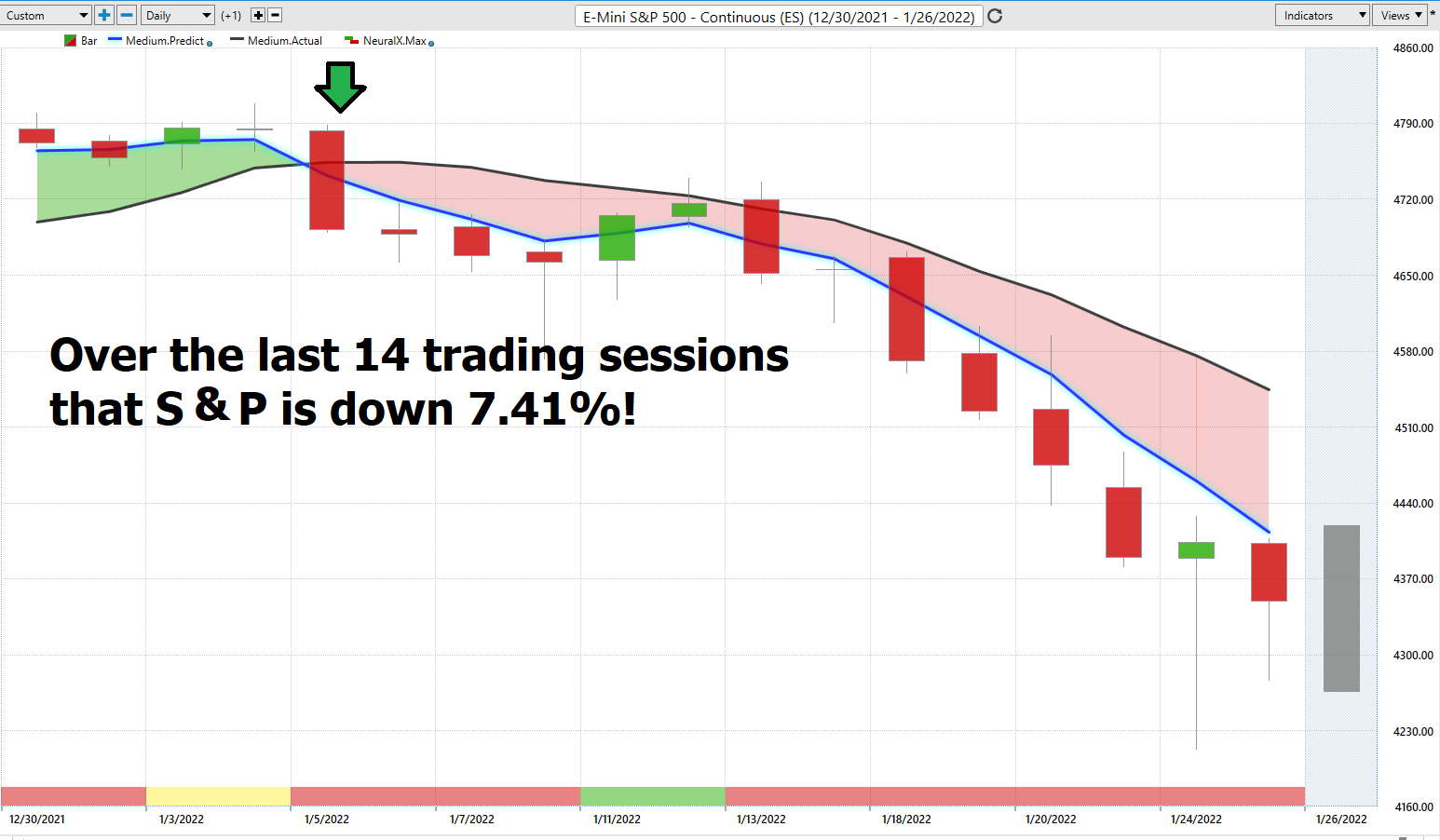
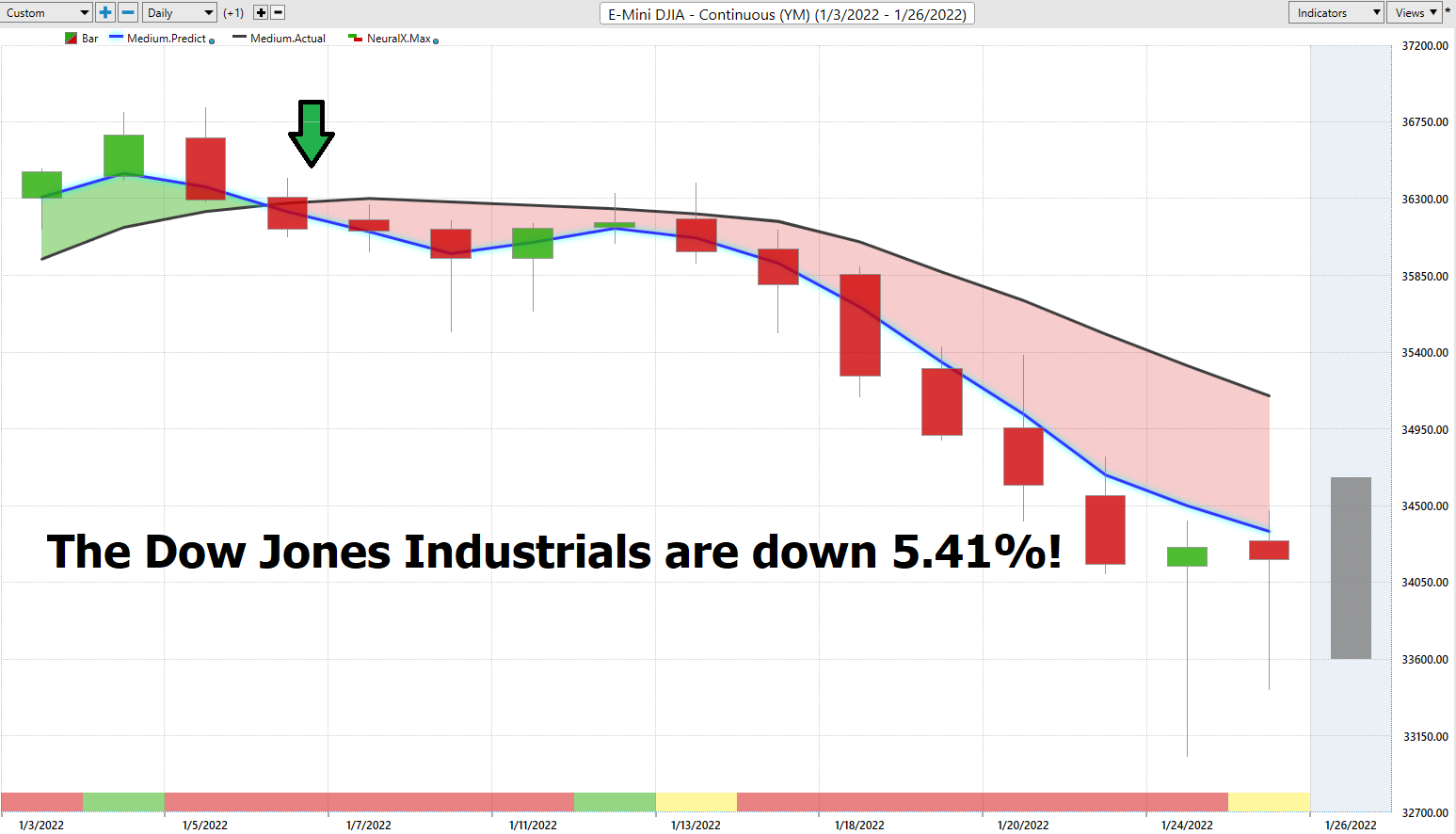
Regardless of how you evaluate the stock market, the TREND is and has been DOWN.
Today there are numerous ways in which a trader can capitalize on a declining market. In this analysis we will analyze and explore the opportunity of INVERSE ETF’ on The Dow Jones Industrial Average. The trading symbol is $DOG.
An inverse ETF is an exchange traded fund (ETF) created by using various derivatives to profit from a decline in the value of an underlying benchmark. Derivatives are instruments like options and futures contracts. Investing in inverse ETFs is similar to holding various short positions, which involve borrowing securities and selling them with the hope of repurchasing them at a lower price.
An inverse ETF is also known as a “Short ETF” or “Bear ETF.” Traders use inverse ETFs to inversely track an underlying index or group of investments you believe will drop in value. Or they use these instruments to hedge against downside risk in similar investments you own (in a long position).
Inverse ETFs allow investors to make money when the market or the underlying index declines, but without having to sell anything short. The value of the ETF is directly inverse to the value of the Index it is tracking.
The largest and most successful inverse ETFs aim to deliver the opposite returns of major stock indexes, like the Nasdaq or the S&P 500 and the Dow Jones Industrials. While these instruments need to be closely monitored, they help traders chase yield during market dips. They create an opportunity that is easy to access.
The ProShares Short Dow 30 ETF (NYSEARCA: $DOG) delivers inverse exposure to the daily performance of the Dow Jones Industrial Average, which includes the 30 blue chip companies which comprise the DOW.
In this weekly stock study, we will look at and analyze the following indicators and metrics as are our guidelines which dictate our behavior in deciding whether to buy, sell, or stand aside on a particular stock.
- 52-week high and low boundaries
- Best Case-Worst Case Analysis
- Vantagepoint A.I. Forecast (Predictive Blue Line)
- Neural Network Forecast
- Daily Range Forecast
- Intermarket Analysis
- Our trading suggestion
We don’t base our trading decisions on things like earnings or fundamental cash flow valuations. However, we do look at them to better understand the financial landscape that a company is operating under.
Readers may want to review an article we recently wrote which summarizes the current economic environments and the risks it poses for stocks. It is entitled: The Great Unraveling. What Happens When You Push On A String? That article lays out a fundamental trading thesis but we always wait for the a.i. to correlate to that opinion before we take any action in the marketplace.
52-week High-Low Chart
Readers of this blog will attest to the fact that we are huge believers in monitoring where a stock is trading in relation to its 52-week range. Our perspective is that winners continuously make new 52-week highs, and we want to be on board for those types of moves. We pay a great deal of attention to how a stock reacts and performs in relation to its 52-week high and low boundaries.
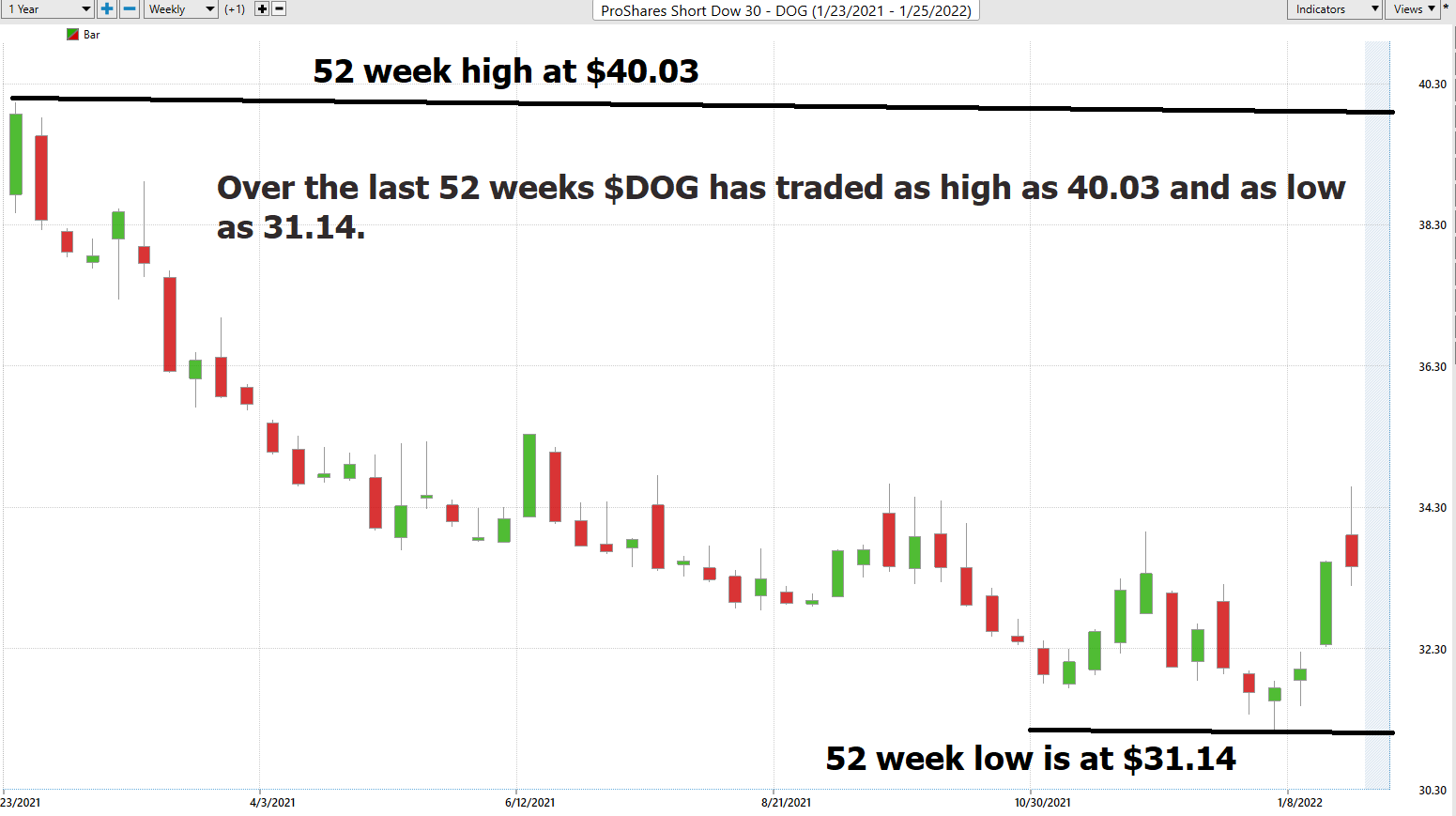
Over the last 52 weeks $DOG has traded as high as 40.03 and as low as 31.14.
Since this is an INVERSE ETF on the DOW Jones Industrials for every 1% that the DOW goes down it should move 1% higher.
Based upon the high and low prices we can quickly see that the annual trading range of $DOG has been $8.89. This tells us that the average weekly trading range is roughly .17.
What we often like to do as well is to divide the annual trading range (8.89) by the current price ($33.22) this gives us a very basic estimate of annualized volatility. Current annualized volatility is 26.7%. This metric essentially tells us that in one year, we can expect $DOG to be trading 26.7% higher of lower from current levels.
We refer to these as the commonsense metrics which we use as baseline measurements of understanding normal value. When using artificial intelligence, we look to amplify our returns based upon these baseline measurements.
The chart below is a five-year weekly chart of $DOG This chart gives us a very good longer-term perspective of the longer-term trend. Our first challenge is to recognize that this is an upside-down inverse image of what the Dow Jones Industrials has done over the past 5 years. In other words, we can see that the DOW has rallied significantly.
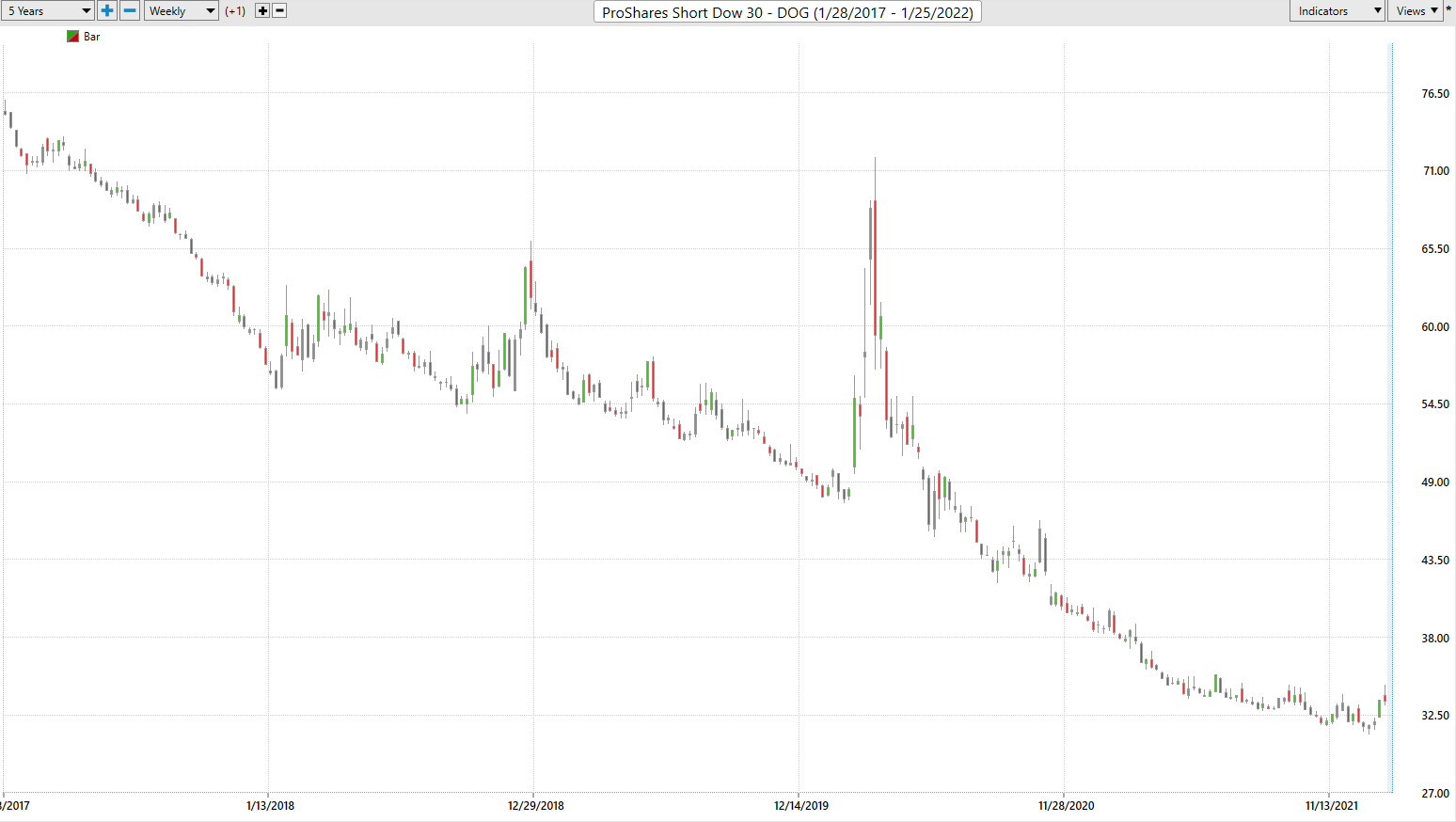
What we like about this situation :
Fundamentally the market is overvalued by all valuation metrics. While we don’t trade on fundamentals, we have learned that when the a.i. creates a DOWN forecast it presents a great opportunity in this environment.
The market has resistance at its current weekly high. We think if that gives way the opportunity for another 6% to 10 gains will occur very quickly. Finding buying opportunities in this INVERSE ETF on pullbacks with good money management stops is something traders might want to consider.
Best Case – Worst Case Scenarios
Next, we want to look at the trend over the past year and evaluate the strength of the rallies in relation to the declines.
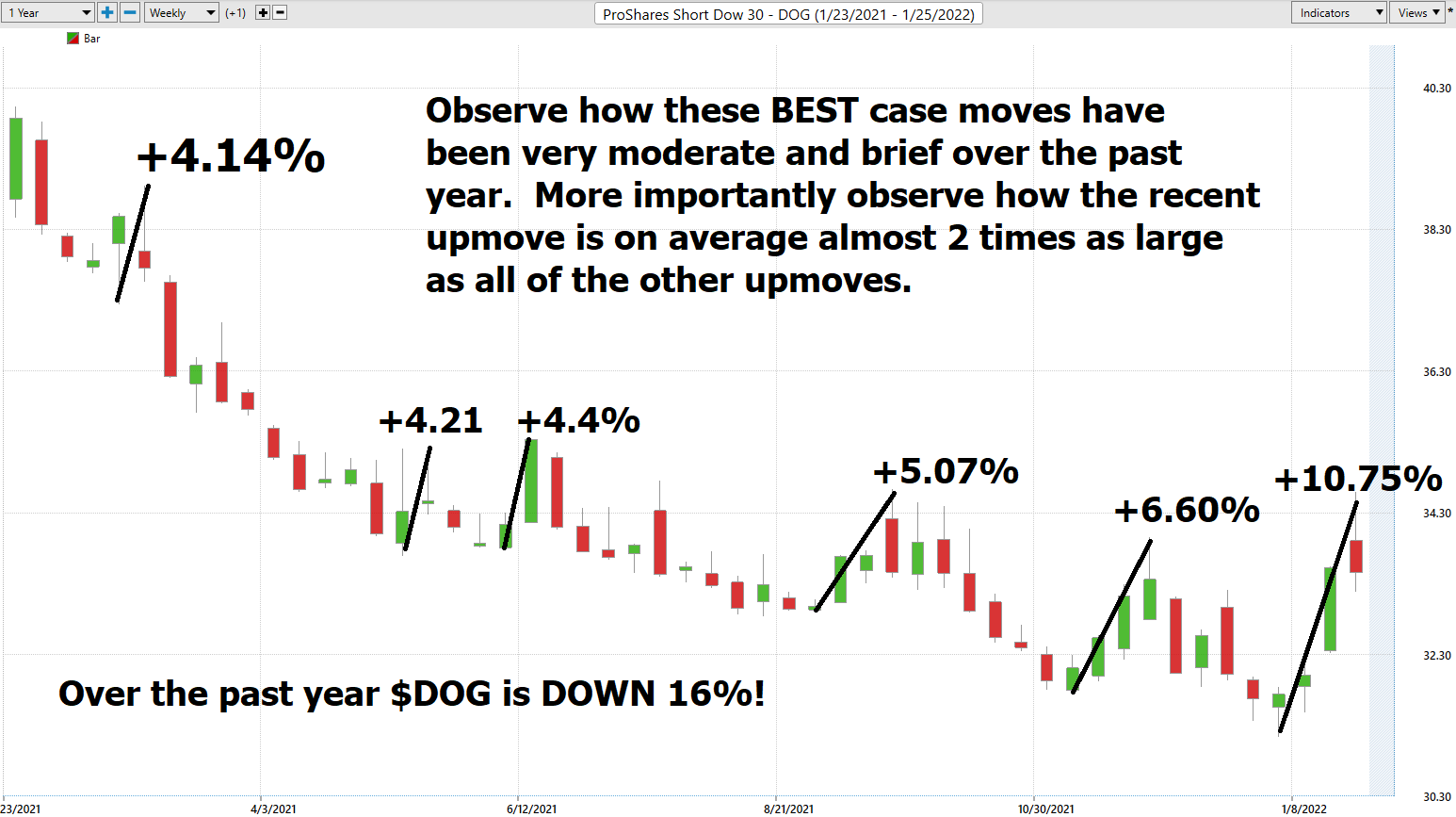
Over the past year:
$DOG over the last 52 weeks is DOWN 16%.
The DOW Jones is Up 12%. The reason this disparity exists is simply because I am measuring the decline in DOG for the 52-week High which occurred at the beginning of 2021.
S&P 500 Index +14.9%
NASDAQ +12.82%
Russell 1000 Stock Index is up + 25.09%
What can we learn from these short erm rallies? First off, we can clearly see that rallies in this market have been very short lived. So, as traders we know going in that we are initially looking at a short-term swing trading opportunity.
The Vantagepoint A.I. Analysis
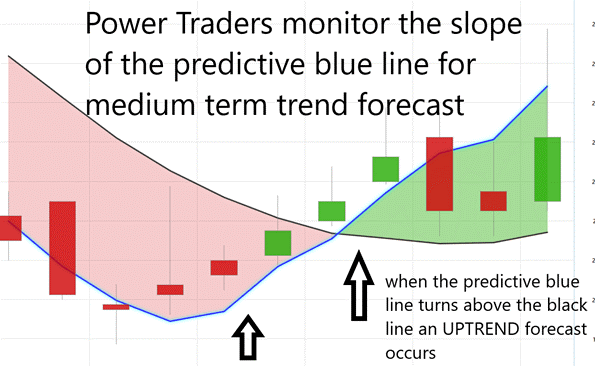
Using VantagePoint Software and the artificial intelligence, traders are alerted to trend forecasts by monitoring the slope of the predictive blue line. The black line is a simple 10 day moving average of price which simply tells you what has occurred in the market. The predictive blue line also acts as value zone where in uptrends traders try to purchase the asset at or below the blue line.
In studying the chart below pay close attention to the slope of the blue line. Anytime the blue line crosses the zero intercept is a trend signal. If the line crosses from down to up, an UP-trading opportunity exists. If the line crosses from Up to down the down trading opportunity exists.
The most recent UP forecast on 1/13/21 occurred at a price of $31.81.
Power traders use the predictive blue line in helping to determine both the value zone as well as the trend direction.
Observe how the SLOPE of the predictive blue line started moving higher a few days before its moving above the black line. A very strong trend was evidenced by seeing that price was consistently closing above the predictive blue line.
Fine Tuning Entries with The Neural Net Indicator
At the bottom of the chart is the Neural Network Indicator which predicts future strength and/or weakness in the market with a 48-to-72-hour time horizon.
A Neural Net is a computational learning system that uses a network of functions to understand and translate massive amounts of data into a desired output, consistently monitoring itself and improving its performance.
When the Neural Net Indicator is green it communicates strength. When the Neural Net is Red it is forecasting short term weakness in the market.
We advocate that Power Traders cross reference the chart with the predictive blue line and neural network indicator to create optimal entry and exit points. This provides what we refer to as the DOUBLE CONFIRMATION setup.
Power Traders are always looking to apply both the neural network and a.i. to the markets to find statistically sound trading opportunities.
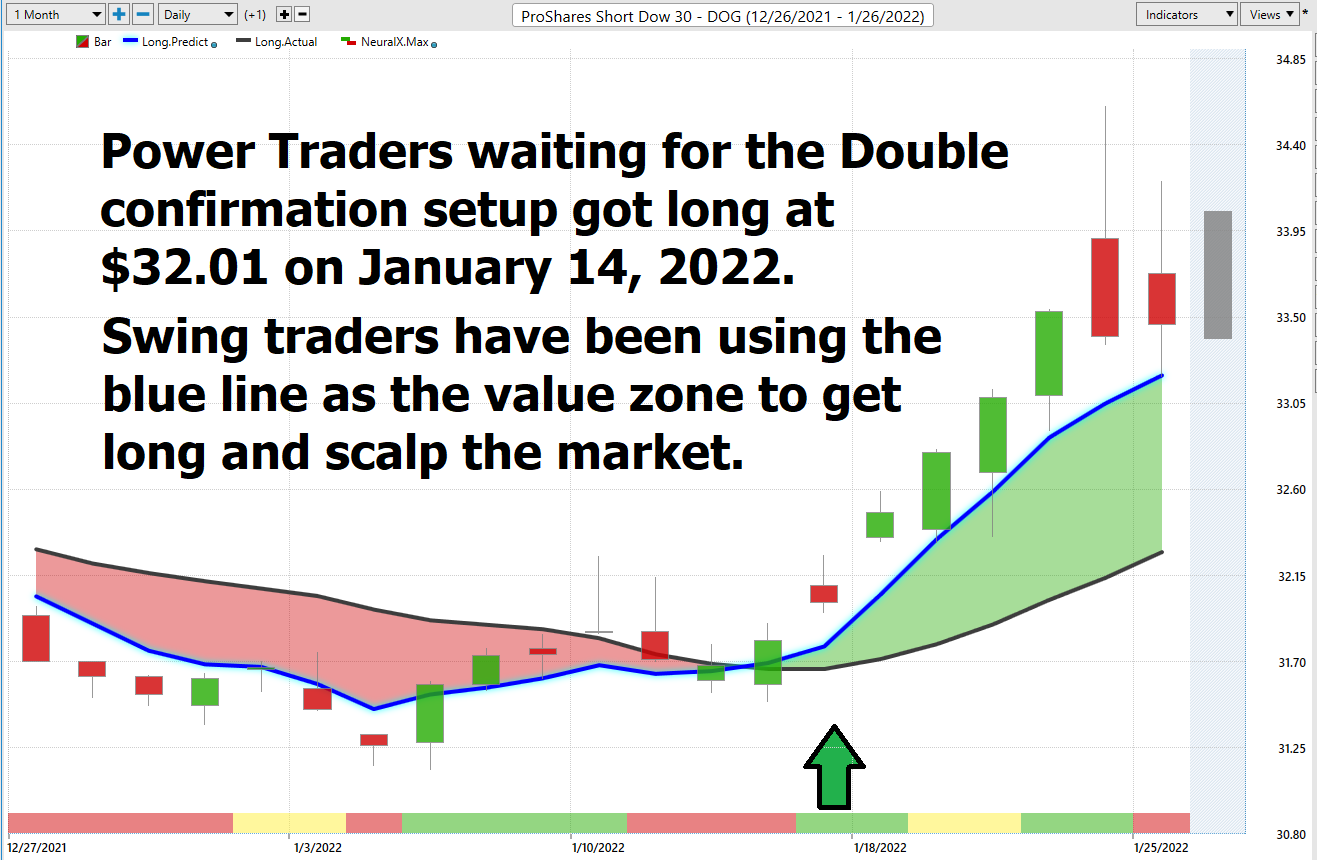
We advise Power Traders to cross reference the predictive blue line with the Neural Net for the best entry opportunities. Observe how by simply waiting for the green Neural Net to align with the predictive blue line the trading opportunity unfolded beautifully generating 24% gains in just the past few weeks.
VantagePoint Software Daily Price Range Prediction
The purpose of all these indicators so far is to help traders stay on the right side of the right trend at the right time.
One of the powerful features in the Vantagepoint A.I. Software which Power Traders use daily is the Daily Price Range prediction forecast.
This forecast is what permits Power Traders to truly fine tune their entries and exits into the market often looking for smaller time frames and more granular trading opportunities.
Here is the price chart of $DOG during the most recent runup featuring the Daily Price Range forecast and the Neural Net Indicator.
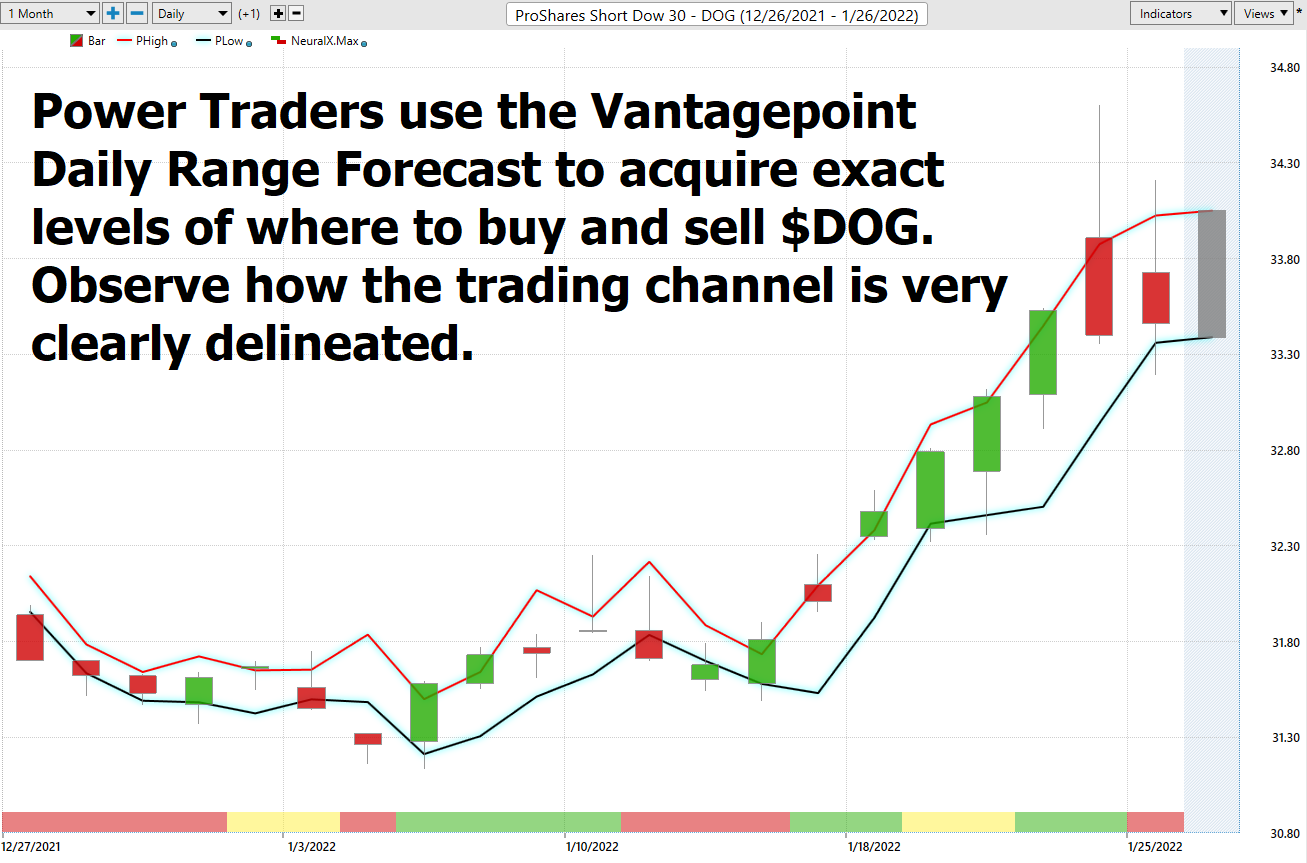
All of the tools so far in this analysis attempt to define value and to clearly identify the trend and points within the trend where traders should look to capitalize on.
Intermarket Analysis
What makes the Vantagepoint Software truly unique is its ability to perform Intermarket analysis and to locate those assets which are most interconnected that are responsible for driving the price of $DOG higher or lower.
Studying the charts can always provide objective realities in terms of locating support and resistance levels which become very clear on a chart. But we live in a global marketplace. Everything is interconnected. The billion-dollar question for traders is always what are the key drivers of price for the underlying asset that I am trading?
These intangibles are invisible to the naked eye yet show very high statistical correlations. Small changes in Interest rates, Crude Oil Prices, and the Volatility of the dollar amongst thousands of other variables affect the decisions companies must make to survive in these very challenging times. Trying to determine what these factors are is one of the huge problems facing investors and traders.
$DOG has a 99.49% annual correlation to the Dow Jones Industrial Average. It is also 88.59% inversely correlated to the Japanese Yen on a yearly basis. What is also fascinating is that $DOG is also negatively correlated to the Interest Rate markets. This factor reminds us of the old Warren Buffet adage, “if rates are low, stocks can grow. If rates are high, stocks can die.” This is important at this juncture because the Fed is threatening to raise rates starting by the end of March.
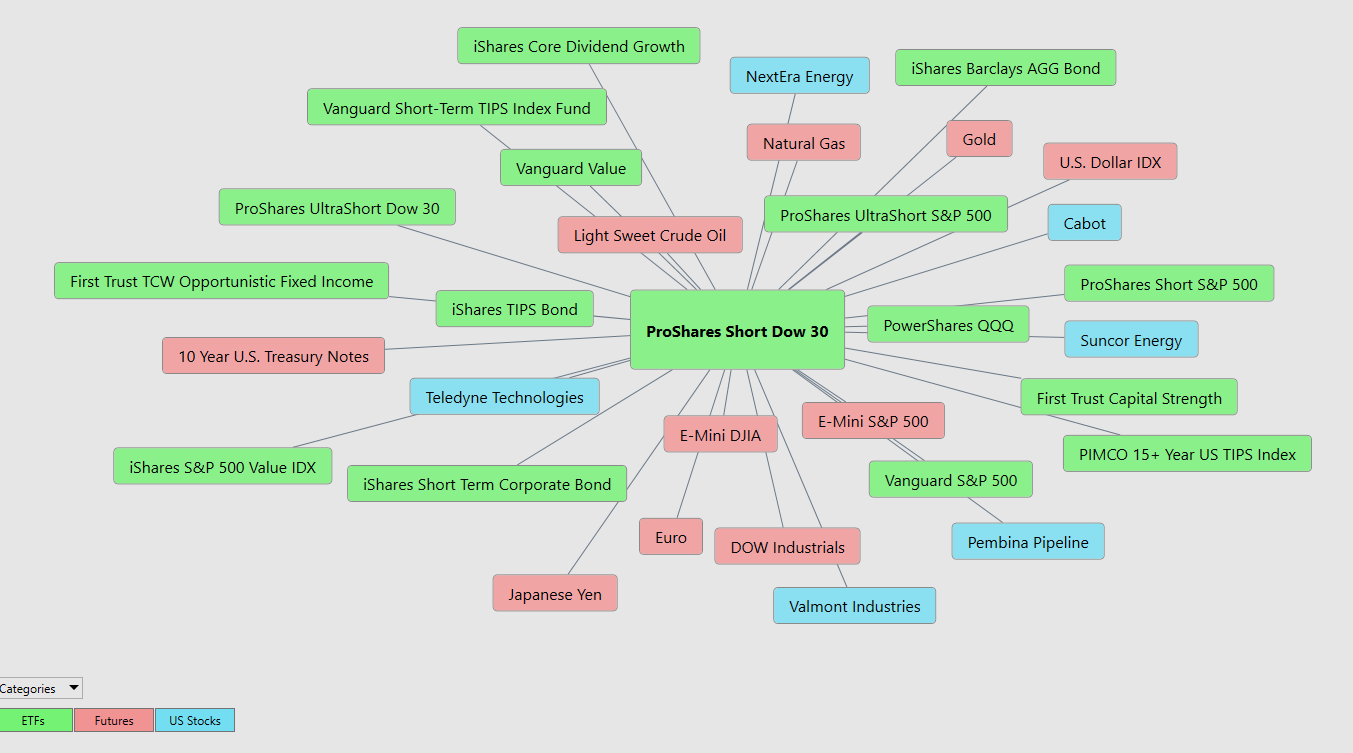
There is great value to be had in studying and understanding the key drivers of $DOG price action. This graphic presents a plethora of opportunities that can quickly be explored within the software.
This is an amazing research tool that consistently uncovers future gems.
Our Suggestion
In our estimation, and as we have written extensively in our blog posts over the past few years, what is driving the stock markets is a chase for yield, all fueled by Fed Stimulus and low interest rates. This craze has been in play since the Great Financial Crisis of 2008. The Fed is trying to remove the punchbowl from the party without crashing the markets or the economy. Over the last 13+ years they have tried multiple times to cut bond purchases and raise rates and each time their attempts have been met with sharp selloffs in stock prices.
We think the Fed is between a rock and a hard place and as much as they want to raise rates, they recognize that the risk is sky high.
For this reason, along we think that $DOG is worthy of your consideration either as a hedge against your portfolio or to capitalize on a falling market.
The one factor that separates great traders from amateurs is money management.
An amateur trader will risk their entire portfolio on one trade and lives for the adrenalin rush that the risk creates.
Our trades are based upon the a.i. analysis. When it says the trend is down, we have two choices. SELL our long positions and move to the sidelines or look to get short and potentially exploit the market with an Inverse ETF like $DOG.
We think that the volatility will be increasing in stocks throughout 2022. As it does $DOG should do quite well. Look to buy retracements in this asset with tight stops always practicing good money management. And tight stop placement.
We think it is prudent to look for buying opportunities in any breaks in the price action.
We will look for opportunities of sudden breaks in the market if the a.i. forecast remains UP to scale in small positions with tight stop losses.
Let’s Be Careful Out There!
Remember, It’s Not Magic.
It’s Machine Learning.
Disclaimer: THERE IS A HIGH DEGREE OF RISK INVOLVED IN TRADING. IT IS NOT PRUDENT OR ADVISABLE TO MAKE TRADING DECISIONS THAT ARE BEYOND YOUR FINANCIAL MEANS OR INVOLVE TRADING CAPITAL THAT YOU ARE NOT WILLING AND CAPABLE OF LOSING.
VANTAGEPOINT’S MARKETING CAMPAIGNS, OF ANY KIND, DO NOT CONSTITUTE TRADING ADVICE OR AN ENDORSEMENT OR RECOMMENDATION BY VANTAGEPOINT AI OR ANY ASSOCIATED AFFILIATES OF ANY TRADING METHODS, PROGRAMS, SYSTEMS OR ROUTINES. VANTAGEPOINT’S PERSONNEL ARE NOT LICENSED BROKERS OR ADVISORS AND DO NOT OFFER TRADING ADVICE.

